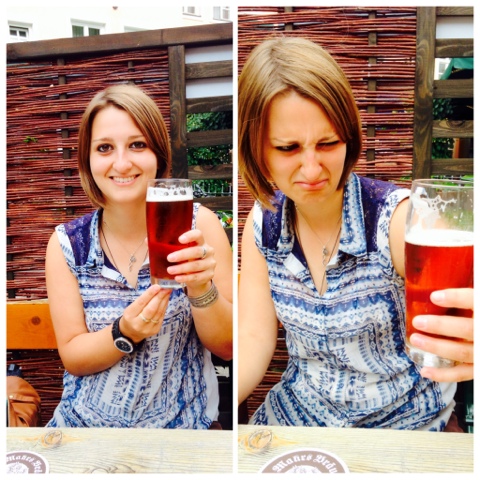Our journey towards Czech Republic took us towards the town of Bamberg which I was interested in stopping in to try the curious local speciality of 'smoked beer'. However it turned out there was so much more to the town than I expected. First, we scored a gorgeous campsite by the river where we were able to put our tents right by the banks and watch the sunset over the water with nary a ripple. Swimming in the heat of the day was also unforgettably lovely and we happily deemed this our favourite campsite and spent a rare day simply relaxing here.
Bamberg surprised me in fact, turning out to be an attractive Medieval town built on rushing waterways. I had expected only beer, but Bamberg provided history -and oodles of it. The centre of the Holy Roman Empire at one point, a focal point of witch trials ending with a tally of over 1,000 victims, and even the temporary relocation of the seat of government of Bavaria when Munich came under communist control in the years following World War I.
The problem of Bamberg was in fact, the beer. Excited to try something new, I soon found out why it remained a 'local' specialty. Yannick, after sampling mine, carefully analysed the flavour as 'off Pastrami', while I was leaning more towards the subtle taste of 'matured with old rubber'.
We passed a very old pharmacy on our wanderings which I thought was rather cool, it had old bottles and items from the 1600s - back when going to the doctors was probably as risky as not going!
The town also had a monastery, although it had been turned into an elderly peoples home (ones with buckets of cash judging from the security and architecture) the facade was pretty to look at and the monastery gardens were very enjoyable to wander. The remains of old orchards dotted the slopes in uniform lines, craggily old apple and pear trees with the fruit lying abondoned on the ground, long forgotten.
My last view of Bamberg as we left it, the rushing of water mingling with the high spirited shouts of tourists watching the sun set from the old stone bridge.
Nuremberg was our last city in Germany and although I had no real expectations it in fact provided me with lasting memories. Not only was Necia able to satisfy her craving for Pimms, but we were also able to try the famous Nuremberg sausages that helped make a name for the German bratwurst - and they were very good too! Called 'Rostbratwurst' these sausages can only be made in Nuremberg - they are even on an official registers recognising locally produced specialties!
These small sausages are eaten in groups of three in a bun (called Weggla) or in groups of six, eight, ten or twelve by themselves. The reason for their small size has a few amusing origin stories, most of which seemed to involve stuffing these sausages through small spaces. One such tale goes that inns were required to close early, so innkeepers made these savoury delights small so they could still give guests who were locked out for the night dinner by feeding them through the keyhole! Another story states that criminals in Nuremberg prison were fed these sausages through a special hole drilled through the wall. I found both these stories somewhat questionable, but enjoyed them nonetheless! We were also lucky enough to visit Nuremburg on market day which meant we couldn't resist buying a couple of punnets of raspberries which we consumed sitting on the sun-soaked stones at the foot of the cathedral.
The second culinary delight of Nuremberg is it's famous gingerbread, called Lebkuchen. It reminded me of a mini Christmas cake, soft and chewy and lightly iced and spiced and lovely. I suppose they have had a few hundred years to perfect the recipe as it was invented by monks way back in the 13th century.
The cathedral of Nuremberg - called St. Sebald - was a poignant reminder of the destruction wreaked by World War Two. Nuremberg was flattened by Allied bombing and the church itself was heavily damaged. In simple pictures and words a small exhibition called 'St. Sebald: a Monument to Peace' displayed the rebuilding of the church as representation of hope. I have copied my favourite words of the exhibition below:
'20th April 1945...
The guns are silent.
Nuremberg: fallen
Laid down in the horror of a war
No one had imagined it would be like that...
Torn, broken through, empty
Sebald's towers reach towards Heaven'.
'Peace - what is peace?
That we can go through the ruins
Without fear of bombs?
That the sun warms people and stone
As if nothing had happened?
That the horror is already beginning
To belong to the past?
17. December 1992
100 000 citizens
Carrying burning candles
Form a circle round the heart of the city.
The seeds of violence
Must never germinate again
In our city!'












No comments:
Post a Comment